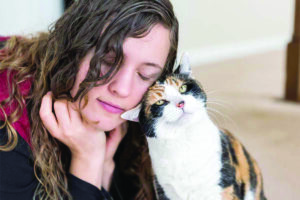By Dr. Beth Leermakers
Dogs have owners, cats have staff.
She loves me, she loves me not. Does your cat really love you, or does she just think of you as her personal chef and maid? Several research studies have examined whether cats love people like dogs do. Here are a few scientific indications that cats do care for their people.

Photo courtesy of Fearfreehappyhomes.com
Social referencing. Does your cat look to you for guidance? Social referencing means using cues for how to behave in novel situations. For example, a baby who laughs when her mother does is using social referencing. The baby doesn’t understand the joke but imitates the response to it. In one study, researchers put cats and their owners in a room with a potentially scary fan. The owners were told to act neutral, afraid of the fan, or happy and relaxed around the fan. Most (79 percent) of the cats looked between the fan and their owner, appearing to evaluate their responses. The cats were more likely to move away from the fan when their owner looked scared of it.
Voice Recognition. Does your cat know your voice? Researchers examined whether domestic cats recognize their peoples’ voices without them being present. In one study, the cats sat alone in a room away from their owners, and the scientists recorded the animals’ responses to different voices calling their names. Fifteen of the 20 cats appeared to distinguish their owners’ voices from those of other people.
Attachment. Are cats loyal to one person? Some cats ignore — or avoid out of fear — everyone except their “person.” Examining the attachment behaviors cats exhibit toward people, researchers discovered that cats definitely bond with people. Some cats may even display separation anxiety when their people aren’t home. Other studies indicate that some breeds are more likely to form special bonds with just one person than to love everyone they meet. Those one-person pets don’t follow this strategy: If you can’t be with the one you love, love the one you’re with.
One study examined whether 70 adult cats displayed “secure” and “insecure” attachment like people and dogs do. The researchers placed a cat in a room with his owner for two minutes, and then the owner left for two minutes. Researchers observed the cats’ behavior when the owners returned. More than half (63.4 percent) of the cats showed signs of secure attachment, meaning they felt safe exploring their surroundings and trusted that their owner would take care of their needs. A secure cat greets his owner and then goes back to what she was doing. The other cats displayed “insecure” attachment, appearing to feel anxiety or fear toward their people. Those cats ignored their person completely when they returned — or clung to them. Other signs of fear/anxiety included licking their lips and twitching their tails. Similar research in humans and dogs found that 65 percent of children and 58 percent of dogs showed secure attachment to their people.
Socializing. Would your cat rather eat or spend time with you? No kidding. Researchers gave cats a choice of stimuli (food or socializing with people). Most of the feline subjects preferred hanging out with people first, then food.
What’s your cat’s love language? Look for these signs that your cat is fond of you:
• Purring. Purring can also indicate stress, so pay attention to the other cues to determine whether your cat’s purring is positive or negative.
• Sitting on your lap.
• Rubbing her head against you. Called scenting, this behavior is a sign of affection.
• Licking you.
• Head butting you.
• Slow blinking. This signals contentment.
• Exposing her belly to you. Cats only do this with their favorite people.
How to Bond with
Your New Cat
1. Respect her space. Cats need their own safe space to relax and feel secure. Let your new cat come to you in her own time and space.
2. Spend time together. Engage in quality-time activities such as playing, grooming or simply sitting together. Take the time to observe your cat’s behavior and get to know her preferences. Where does she like to be petted?
3. Use positive reinforcement. Reward your cat with treats and praise when he does something right to reinforce desired behavior. Positive reinforcement encourages a strong bond between you and your pet.
4. Communicate clearly and regularly. Talk to your cat in a calm, gentle voice, and use his name often. When you speak in a soft tone and look into your cat’s eyes, your kitty will know you’re communicating with him and appreciate your attention.
5. Show physical affection. Many cats enjoy gentle petting or cuddles after they’re comfortable with you. Give your cat plenty of love if she’s receptive, while respecting her boundaries.
If you’ve been thinking about adopting a cat but aren’t sure pet parenthood is right for you, consider fostering a kitten or adult cat through Dallas Animal Services or a local cat rescue. Visit petfinder.com to find DFW-area cat rescues.
Happy Valentine’s Day!
